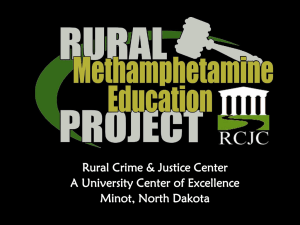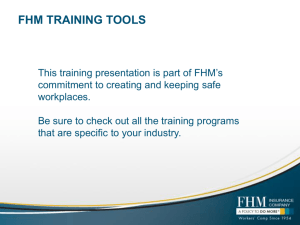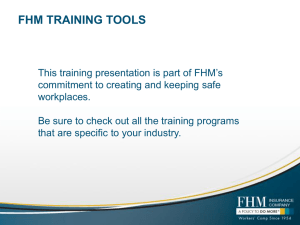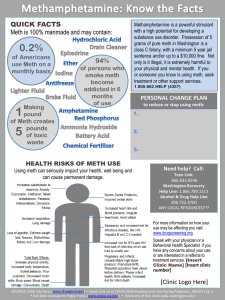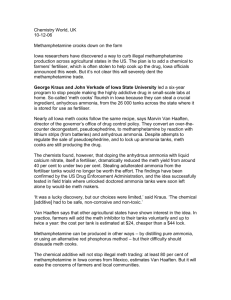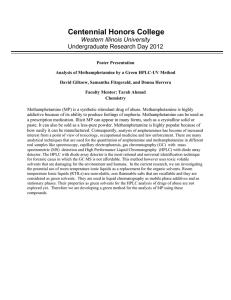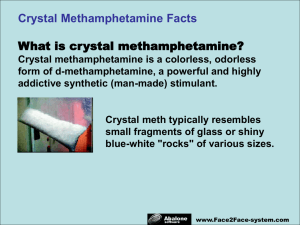10 lesson plan Evaluating crystal meth education tools
advertisement
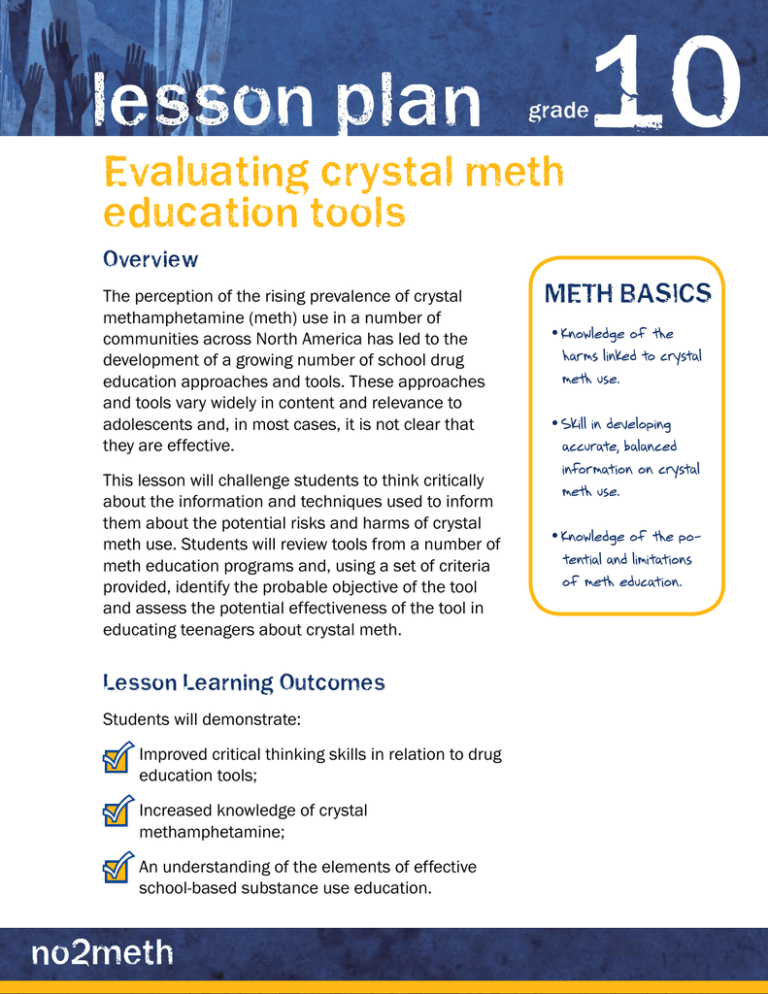
lesson plan 10 grade Evaluating crystal meth education tools Overview The perception of the rising prevalence of crystal methamphetamine (meth) use in a number of communities across North America has led to the development of a growing number of school drug education approaches and tools. These approaches and tools vary widely in content and relevance to adolescents and, in most cases, it is not clear that they are effective. This lesson will challenge students to think critically about the information and techniques used to inform them about the potential risks and harms of crystal meth use. Students will review tools from a number of meth education programs and, using a set of criteria provided, identify the probable objective of the tool and assess the potential effectiveness of the tool in educating teenagers about crystal meth. Lesson Learning Outcomes Students will demonstrate: Improved critical thinking skills in relation to drug education tools; Increased knowledge of crystal methamphetamine; An understanding of the elements of effective school-based substance use education. no2meth METH BASICS » •Knowledge of the harms linked to crystal meth use. » •Skill in developing accurate, balanced information on crystal meth use. » •Knowledge of the potential and limitations of meth education. Links to BC Curriculum PLO • Planning (2004) Health Decisions: Analyse strategies for preventing substance misuse (e.g., recognizing influences, assessing accurate information, applying informed decision-making skills); Health Information: Analyse health information for validity and personal relevance. • Social Studies (2006) Skills and Processes of Social Studies: Apply critical thinking skills, including questioning, comparing, summarizing, drawing conclusions, defending a position; Demonstrate effective written, oral, and graphic communication skills, individually and collaboratively. p. - grade 10 no2meth Make copies of: •Crystal Methamphetamine Fact Sheet •Evaluation Worksheet •Word Puzzle •Word Find •Methamphetamine Quick Facts •Making the Band •Meth Mouth Poster lesson plan - grade 10 Preparation and Materials •Education Tool Analysis Form (one for each group) •Home Link Activity Guide Time Frame 11 12 1 2 10 3 9 8 4 7 6 5 45 minutes no2meth grade 10 - p. Procedure Lesson starter Indicate that: methamphetamine (meth) is a substance of 1 Crystal great concern in many parts of the U.S.A. and in Western Canada. have responded with a variety of strategies 2 Governments and methods to try to prevent the use of crystal meth among youth. of these crystal meth-specific education methods or 3 Few tools have been evaluated. 4 In this class, the students will have the opportunity to take on the role of “evaluation experts” and will review a variety of tools that are currently available. Activity 1 (small group) • Divide the class into groups of 4 to 6 students, depending on the class size. • Have each group review and evaluate the five educational tools provided by completing the Evaluation Worksheet using the Crystal Methamphetamine Fact Sheet as a resource. p. - grade 10 no2meth • After 15 to 20 minutes of small group discussion, ask the groups to share their responses with the full group. • Record and collate the responses across the groups. • Summarize the discussion with a list of the students’ advice for enhancing the potential effectiveness of crystal meth use prevention education. • While the group representatives are presenting their ideas, watch for evidence that the group’s discussion generated an understanding of relevant facts and necessary skills as well as evidence of critical thinking related to effective approaches for delivering prevention messages. Use the information to complete an Education Tool Analysis Form for each group. lesson plan - grade 10 Activity 2 (full class) Closing question • Ask the class to suggest three “rules” or guidelines that they would wish to share with adults who are developing crystal meth education resources. no2meth grade 10 - p. Closing point • If it isn’t raised by the class, mention that a “rule” for current evidence-based programs is the need for balance in describing the effects of a substance – that is, to acknowledge that users often pursue perceived benefits from their use of substances, including crystal meth, at least in the short-term, for example in relation to self-esteem, making social connections, heightening sexual experience, and facilitating weight loss and wakefulness, and that effective educational methods and tools need to help students identify alternative ways of obtaining these same benefits. • If time remains in the class, brainstorm alternative, less risky ways of achieving these benefits; or consider addressing this in another class. Assessment Critical thinking skills are an essential component of assessing the information presented in substance use prevention and education tools. This particular set of activities provides students with an opportunity to reflect on the information, formats, and approaches used to present them with educational materials related to substance use in general and crystal methamphetamine use in particular. It asks them to critically evaluate the potential impact of the tools and to suggest potentially more effective tools. The predominant activity here takes place within a group setting. Rather than focus on individual students, the assessment approach for the activities included here centres on the critical thinking skills of each small group. The assessment tool the Education Tools Analysis Form, focuses on three distinct aspects of critical thinking: identifying strengths and weakness of material; comparing and contrasting material; and suggesting alternative tools. p. - grade 10 no2meth • One of the techniques studied in this lesson, Meth Mouth Poster, was an example of a “scare” approach to drug education, portraying the dental problems that can occur with long-term use of crystal meth. This approach is generally not supported by experts but as can be seen, it is still used because some argue that it can be effective. • An alternate approach is to present balanced information that acknowledges the fact that people who use a substance do so because they are in pursuit of a perceived benefit. Acknowledging this allows for discussion about possible benefits and accompanying dangers. It also opens up the possibility to discuss less risky ways to obtain the desired benefits. • In this activity, students are invited to engage their parents in a discussion of Tactics in Drug Education. No materials are really needed but a copy of the Meth Mouth Poster might help stimulate discussion. lesson plan - grade 10 Home Link Extension activity • Ask students to perform a web search to find their own examples of crystal meth education tools to share with the class and evaluate through small group work. • Ask the students to use their experience in reviewing the existing resources to develop a prototype of a potentially more effective crystal meth education resource or approach. no2meth grade 10 - p. Evaluation worksheet 1 Which of these five tools is least effective in helping you learn about the risks of using crystal meth? Why? 2 Which of these five tools helps you best understand the risks of using crystal meth? Why? 3 What do you see as the strengths of each of the five resources? p. - grade 10 no2meth Evaluation worksheet 4 What do you see as the weaknesses of each of the five resources? 5 The two posters contain graphic and startling images? Is this an effective approach? If so, why? and for whom? If not, why not? 6 What do you believe are the three most important facts adolescents need to know to influence them not to try crystal meth? no2meth grade 10 - p. 1. Word puzzle For each letter of the word “methamphetamine”, think of a word or words that describe Meth which include that letter. Here is an example using the word “cat”. Clever plAyful liTterbox Possible solution to the puzzle: M E T H A M P H E T A M I N E p. 10 - grade 10 Man-made dangErous sTimulant Harmful illegAl Strong sMells Paranoia Hazardous chemicals dEath neuroTransmitter dopAmine probleMs vIolence iNcreased heart rate strokE no2meth 2. Word find M F R E Y I O J A M K L D H D O P A M N E B H P A E G R M J K L P O I U O Y O O A I U W Q A V L A S S T R O K E Z X V I O P P D F S F T R U T U P S K H H A G G R E S S I V E G G S I V A W Q P I A E I W A A H P W S T I Z E R T R I B O D Y O D O R R N O P A M I N S E C N M T G H V E A W E D S F A T S P A Z E P I O W E I U E C H E M I C A L S B N I O N A R N S H R I D E F N O T T U H O D Y D O O V R O N D O V O E S T E R S T H R A N E D L O V I E E L T H C R Y S T A L M I M A T E R O I Y A N A O S T C R A N K I S A S K O L T O S N A C N E D E O N Y Y A N K E E S Q M A N K I N C A B T D S R L O S T H O M P S O N H I I J K L M A R S I S O E A P I S D C L A N D I S T I N E L A B L T O A X D M I L L E G A L A R S O N A N E B O N Y R N Y F O X METHAMPHETAMINE STROKE BODY ODOR CHEMICALS CRYSTAL ILLEGAL SCAB no2meth SKIN SORES ICE AGGRESSIVE HYPERTENSION PARANOIA DOPAMINE CLANDESTINE LAB I T ADDICTION ASSERTIVE PASSIVE PSYCHOSIS CRANK grade 10 - p. 11 3. Methamphetamine quick facts What is methamphetamine? Meth is a powerful synthetic central nervous system stimulant. What does Meth look like? Pure methamphetamine is a white, odorless powder, Most “home-made” meth is off-white or yellowish in color. The smokeable form of the drug, methamphetamine hydrochloride is often called “ice” because of its clear, chunky crystals that resemble frozen water. M Methamphetamine is referred to by many names-“Crank”, “Speed”, “Meth”, “Crystal Meth”, “Go-Fast”, “Tweak”, “Christy”, or “Zip” Methamphetamine Hydrochloride (the smokeable form) is called— “Ice”, “LA’, “Glass”, or “Quartz” How do people use meth? Meth can be smoked, snorted, injected intravenously or eaten. Is there a meth lab in your neighborhood? Some signs to look for — Unusual, strong odors (like urine, ether, ammonia, acetone, or other chemicals) Excessive trash that includes things such as drain cleaner bottles, starting fluid cans, pill bubble packets, battery casings Unusual amounts of glass containers being brought into the residence Residences with their windows blacked out Renters who pay their landlords in cash Unusual amounts of traffic, especially late at night To report suspicious activity or suspected meth lab dump site, contact local police. p. 12 - grade 10 no2meth 4. Making the Band This is an in-class activity facilitated by a teacher. The following are the directions for the students to work through the activity with the teacher in the classroom. Description: 1 Make a list of the drugs the children have heard about and discuss what they know about them. Make a list of general questions that arise from the class discussion. The following list provides an example of key questions: • What does this drug look like? • What does it do to you (your mind/body)? • Why do people use drugs? • Who uses drugs? • Are there other names for this drug? • Where do people get drugs? • What do young people generally think of others who do drugs? • What are the laws against young people using these drugs? • Where can you go for help when using drugs? Have students write down these questions and any others like these. Come up with at least 8 to 10 questions. The questions need to be ones most commonly asked by young people and focused on what they want to know. The students will use these questions in the next activity within the lesson. 2 Divide the class into at least 6 groups (one group for each type of drug listed on the board). Assign students to the groups to ensure each group is well balanced with students who are writers, artists, idea makers, etc. These groups should emulate a mixture of talents as well as personalities. 3 Assign a different “drug” to each group. The groups are now going to become their own “band” (rock, rap, country, jazz — what ever they decide as a group). Working together, they will write a song about the drug assigned to them. This is an anti-drug song. Encourage students to make their song rhyme and flow. They can use music that they are familiar with, if needed, or create their own tune. The lyrics must be original from the group. no2meth grade 10 - p. 13 Making the Band 4 Students will need to research the effects of their assigned drug and include answers to the questions originally asked in the first section. Encourage them to use the vocabulary list and Deadly Highs, The Hard Facts handout as starting points. 5 Along with writing a song, each group needs to come up with a band name and album or CD cover. These also need to reflect an anti-drug message. The album or CD cover can be designed to reflect the actual size of a CD or album cover (using poster board) or use larger poster board size. This is where their imaginations can go wild. Encourage the students to be creative. 6 Students should also come up with at least one sponsor for their album. They will need to research and gather information from specific information sites. This research can be done through visits to the school library, public library or web site information. 7 Once each group has written their song, designed their album and come up with their name and sponsors, they will need to put on a “concert” for the class. Again they have a choice and can use their imagination. They can perform the song as a group, or if available, videotape the song (like a music video) to play for the class. 8 As each group has a chance to perform, the other students should evaluate the bands using the Group Evaluation Form [Not included here]. Students should complete the form for each group/band performance and be prepared to offer verbal feedback to the performing group after the presentation. Make sure the students include praise along with positive comments about what they learned from the songs. 9 The last question on the sheet asks students to write down the “most positive” thing they learned from the song they heard. As a closing class discussion, have students share their answers to the last evaluation question. Write their comments on the board, overhead or large bulletin paper. Students will feel knowledgeable and productive as they freely share learned information with other students. p. 14 - grade 10 no2meth 5. Meth mouth poster Join Gov. Phil Bredesen and your District Attorney in the fight against meth. no2meth grade 10 - p. 15 Education Examples Analysis Tool Group of students being rated: Rating Categories Critical Thinking Skills Level One (1) Level Two (2) Level Three (3) Ability to identify strengths and weaknesses of the material reviewed Group members could not identify strengths and weaknesses of the material reviewed. While group members did identify strengths and weaknesses of the material reviewed, they seemed to find it difficult to do. Group members were able to identify and easily describe several strengths and weaknesses of the material reviewed. Ability to compare and contrast the education tools Group members could not compare and contrast the education tools reviewed. While group members did compare and contrast the education tools, they seemed to find it difficult to do. Group members were able to easily compare and contrast the education tools reviewed. Ability to suggest alter- Group members could natives not suggest alternative ways of presenting the educational information covered in the material reviewed. While group members did suggest alternative education tool ideas, they seemed to find it difficult to do. Group members were able to easily suggest alternatives to the education tools. Overall Level p. 16 - grade 10 no2meth Tactics in Drug Education grade 10 home link activity guide Guide for Students and Parents: In the lesson plan, Evaluating Crystal Meth Education Tools, students assessed some tools for crystal methamphetamine education. One of the tools studied in this lesson, Meth Mouth Poster, was an example of a “scare” approach to drug education, portraying the dental problems that can occur with long-term use of crystal meth. This approach is generally not supported by public health experts but as can be seen, it is still used because some argue that it can be effective. Another approach to drug education contends that virtually everyone in society is a “substance user”, whether the drug is alcohol, caffeine, prescribed medications (like pain killers, anti-depressants or sleeping pills) or one of the illegal drugs. This perspective holds that it is important to be honest about the place that substances hold in our lives and acknowledge that, whatever the substance, people expect and often perceive some benefit from using it (in many cases benefits – for example, improved feelings – are experienced initially, however it is the nature of moodaltering substances that over time these effects often diminish and change resulting in negative effects). This “balanced” approach allows for a similar discussion and decision-making process whatever the substance in question, whether it’s alcohol, a prescribed substance, or an illegal one. What are the perceived benefits and the accompanying risks? Are there less risky ways to obtain the desired benefits? Students are encouraged to invite their parents to engage in a discussion of Tactics in Drug Education, and discuss the pros and cons of these and other possible approaches. No materials are really needed but a copy of the Meth Posters might help stimulate discussion. Basic ground rules might help, such as: everyone’s opinion is respected; one person at a time speaks; everyone has an equal opportunity to express themselves. Wrap-up thought: if you have a good discussion as a family and arrive at a common view of how drug education ought to be taught, pass on your thoughts and reasoning to the Centre for Addiction Research (CARBC), a body that has a strong interest in this issue. You can reach the Centre through the websites at www.no2meth.ca or www.silink.ca. no2meth grade 10 - p. 17 METHAMPHETAMINE fact sheet Methamphetamine: what’s in it and how it works Methamphetamine is a powerful drug – a stimulant. Like all stimulants, including coffee and cocaine, methamphetamine increases the activity of your nervous system, speeding up your heart rate and breathing, and stimulating the brain. Methamphetamine comes in many forms: pills, capsules, powder, or crystals (which look like shards of ice or glass). Most commonly, people smoke or swallow it. Some people may snort or inject it. The effects of the drug can last for an entire day. Some methamphetamine pills are manufactured legally by pharmaceutical companies. Most methamphetamine however is made in makeshift operations by people who don’t always know how to make it properly. These manufacturers may use chemicals extracted from products they buy in stores, such as iodine, drain cleaner, paint thinner, or camping fuel. In Canada, it is illegal to make, sell, buy, or use methamphetamine, unless prescribed by a doctor. forms of meth:... M Pills / Capsules Powder Why do people use methamphetamine Some adults might use methamphetamine because they think it will give them extra energy to help them work or study harder. Other people use the drug for recreational reasons (such as at parties). Some people might just be curious, or use it as an attempt to relieve boredom. There are people who use methamphetamine for medical reasons, such as for Parkinson’s disease. Crystals Teens and methamphetamine Teens may try methamphetamine for many of same reasons as adults, though they might not realize the downside of drug use. Some teens may experiment with methamphetamine because they are curious. They may have heard about the high they can get. Or they may have heard it can help them study. Some may want to experiment and see if the drug makes them more social. Methamphetamine is especially harmful to young people. A teen’s brain is not fully developed. Regular use of methamphetamine can cause brain damage. How common is methamphetamine use in BC? • Approximately 5% of BC public school students in Grades 7 through 12 have tried methamphetamine. • The vast majority of students (86%, according to one survey) have never used any of the “party drugs”, which include methamphetamine and ecstasy. p. 18 - grade 10 no2meth How does methamphetamine affect a person? Methamphetamine affects brain activity by binding strongly with the pleasure receptors in the brain. A low dose of methamphetamine may produce the following effects: an increase in energy and alertness, increased feelings of self-confidence, reduced appetite and improved mental and physical performance. These effects diminish and change with high dose and frequent use. Happiness becomes crankiness. Energy becomes tiredness. Alertness becomes poor memory. Confidence becomes depression. People who use a lot of methamphetamine may begin to feel extremely anxious and miserable. Over time, people may lose interest in their appearance. They can develop tooth and gum problems, or skin sores. They may grind their teeth, or experience tremors, hostility or paranoia. Risks of using methamphetamine Buying and using methamphetamine off the street is risky! Some of the people who make the drug add things that don’t belong to make the production cheaper so they can make more money. This also makes the drug even more dangerous. Regular use of methamphetamine can lead to a need to use more of the drug to achieve the desired effect. This is called tolerance. As a person develops tolerance, their risk of developing dependence to methamphetamine greatly increases. Dependence involves the need to use a drug in order to feel normal and function properly. METHAMPHETAMINE USE IS PARTICULARLY RISKY WHEN A PERSON IS: Mixing methamphetamine with other drugs. Mixing is extremely dangerous because it can lead to overdose and death. Using needles. People who inject the drug are more likely to become dependent or get a serious disease, such as AIDS or Hepatitis C. Pregnant or breastfeeding. Expectant or breastfeeding women should never use the drug. Methamphetamine can have negative effects on baby’s development and growth. A long-term heavy user. Persons who use significant doses of methamphetamine for a long time may stop taking care of their hygiene, or eating and sleeping properly. This combined with the drug’s impact on the brain can lead to significant brain and organ damage. Symptoms of long-term use include: • Hearing or seeing things that are not there • Repetitive behaviour patterns, like picking at your skin, or pulling your hair • Formication (the feeling that there are bugs crawling on your skin) • Paranoid thoughts that can lead a person to be aggressive • Thoughts about hurting yourself or others no2meth grade 10 - p. 19
